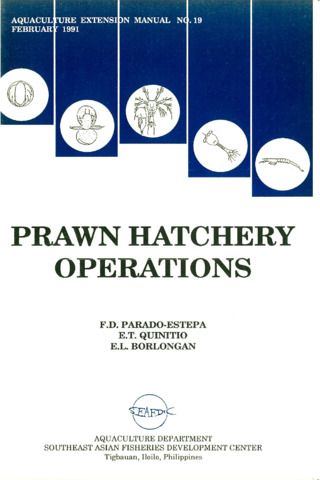The potential effect of greenwater technology on water quality in the pond culture of Penaeus monodon Fabricius
| dc.contributor.author | Tendencia, Eleonor | |
| dc.contributor.author | Bosma, Roel H. | |
| dc.contributor.author | Verdegem, Marc C. J. | |
| dc.contributor.author | Verreth, Johan A. J. | |
| dc.date.accessioned | 2015-05-28T03:29:48Z | |
| dc.date.available | 2015-05-28T03:29:48Z | |
| dc.date.issued | 2015 | |
| dc.identifier.citation | Tendencia, E. A., Bosma, R. H., Verdegem, M. C. J., & Verreth, J. A. J. (2015). The potential effect of greenwater technology on water quality in the pond culture of Penaeus monodon Fabricius. Aquaculture Research, 46(1), 1-13. | en |
| dc.identifier.issn | 1355-557X | |
| dc.identifier.uri | http://hdl.handle.net/10862/2262 | |
| dc.description.abstract | Whitespot syndrome virus (WSSV) has caused severe production drops in the shrimp industry. Numerous scientific manuscripts deal with WSSV epidemiology, but reports on minimizing disease outbreaks through ecological means are rare. Industry stakeholders resorted to various innovative techniques to recover from heavy economic losses. Some shrimp farmers in the Philippines claimed that ‘greenwater’ (GW) technology could prevent disease outbreaks due to WSSV. The efficiency of the GW technology was evaluated by comparing three ponds using the GW culture technique with three ponds not using it. WSSV was detected only in one of the GW ponds and not in the non-GW ponds. No WSSV disease outbreak occurred, and no conclusion could be reached. In GW ponds, available soil sulphur content was lower; and in water, the observed counts of luminous bacteria were lower and counts of Chlorophyceae were higher. Chlorophyceae, i.e. algae, enhanced nutrient uptake in effluent streams resulting in improved water quality in Penaeus monodon Fabricius culture ponds. This suggests that the use of the GW technique to culture P. monodon improved water quality. | en |
| dc.description.sponsorship | The study was funded by the Government of Japan under the trust fund granted to SEAFDEC AQD (GoJ TFD FH0206; 8300-T-RD-FH0710T) and by RESCOPAR funded by INREF of the Wageningen University, the Netherlands. | en |
| dc.language.iso | en | en |
| dc.publisher | Wiley | en |
| dc.subject | Penaeus monodon | en |
| dc.subject | Decapoda | en |
| dc.subject | Chlorophyceae | en |
| dc.subject | Philippines | en |
| dc.title | The potential effect of greenwater technology on water quality in the pond culture of Penaeus monodon Fabricius | en |
| dc.type | Article | en |
| dc.identifier.doi | 10.1111/are.12152 | |
| dc.citation.volume | 46 | |
| dc.citation.issue | 1 | |
| dc.citation.spage | 1 | |
| dc.citation.epage | 13 | |
| dc.citation.journalTitle | Aquaculture Research | en |
| dc.subject.asfa | aquaculture economics | en |
| dc.subject.asfa | chlorophylls | en |
| dc.subject.asfa | shrimp culture | en |
| dc.subject.asfa | White spot syndrome virus | en |
| dc.subject.asfa | bacterial diseases | en |
| dc.subject.asfa | husbandry diseases | en |
| dc.subject.asfa | pond culture | en |
| dc.subject.asfa | mariculture | en |
| dc.subject.asfa | water quality | en |
| dc.subject.asfa | ponds | en |
| dc.subject.asfa | stakeholders | en |
| dc.subject.asfa | aquaculture effluents | en |
| dc.subject.asfa | effluents | en |
| dc.subject.asfa | aquaculture | en |
| dc.subject.asfa | rivers | en |
| dc.subject.asfa | soil | en |
| dc.subject.asfa | economics | en |
| dc.subject.asfa | epidemics | en |
| dc.subject.asfa | nutrient uptake | en |
| dc.subject.asfa | technology | en |
| dc.subject.asfa | innovation | en |
| dc.identifier.essn | 1365-2109 | |
| dc.subject.scientificName | Penaeus monodon | en |
このアイテムのファイル
| ファイル | サイズ | フォーマット | 閲覧 |
|---|---|---|---|
|
このアイテムに関連するファイルは存在しません。 |
|||
このアイテムは次のコレクションに所属しています
-
Journal Articles [1256]
These papers were contributed by Department staff to various national and international journals.




